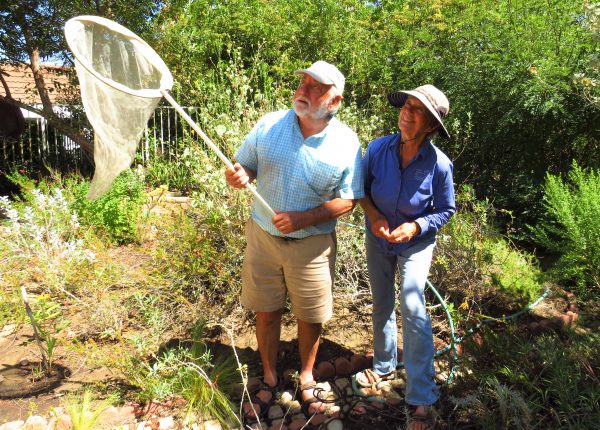
The reductions have become so exponential that some scientists are calling it the tipping point.
Peter Bryant set out with his sweep net on July 4, meandering on a path through native grasses, buckwheat and lemonade berry in a sunny patch of greenbelt near Newport Beach’s Back Bay.
He’s counting butterflies. “There were more than 500 in an hour,” Bryant recalled when he first started counting 34 years ago, less than half a human lifetime ago. “Now, we barely find 15.” That’s a 97% drop. Of the 500, there were 20 different species, he said. The 15 counted this year represented only seven species, a 65% decline.
Bryant, a UCI professor emeritus in the Department of Developmental and Cell Biology, monitors local biodiversity, particularly insects, and counts butterflies for the North American Butterfly Assn. (NABA). His wife, Portia, a now-retired Orange County parks ranger, joined his monitoring efforts in 2006. “I used to see butterflies going around the back of his head,” she said. “Then all of a sudden, boom, they weren’t.”
And it’s not just butterflies. “The verdict is out,” said Scott Black, executive director of the Xerces Society for Invertebrate Protection in Portland, OR. “The vast majority of studies show that insects are rapidly declining.”
Long-term studies indicate less abundance of insects as well as a decline in species, he said. “It doesn’t matter if these studies are in Europe or North America or South America or Africa. The vast majority of studies are showing decline.”
Think about it: How many times did you need to wash smashed insects off your windshield this summer? How many butterflies and bees came to your backyard? How many crickets did you hear?
Declines have become so exponential that some scientists are calling it the tipping point. Insects comprise 95% of the animal kingdom, said Black. “There are more than one million described species and seven to eight million undescribed species,” he said. They stand as the legs of the food web and, if the legs collapse, scientists warn, as they go, we go.
A lot of people make monsters of the tiny critters even though they’re the reason we have fruits, nuts, seeds and vegetables to eat and flowers to enjoy.
“I think everyone knows that one in three bites of our food is due to insect pollination,” Black said. “People look at me and say, ‘You what? You protect insects?’ Yeah, we better. We wouldn’t be on this planet without them.”
Besides humans, insects also feed everything else, mostly directly. Birds, fish, reptiles, amphibians and mammals such as mice and bats eat them and other animals up the food web eat those animals.
Alongside weather events caused by climate change, habitat loss and degradation, urbanization, light pollution and the increasing spread of asphalt and concrete, a major culprit, said Bryant, is the exponential use of pesticides, particularly neonicotinoids.
Neonicotinoids are systemic insecticides applied onto seeds so that every part of the plant is poisonous to food-pollinating, soil-enriching and nectar-seeking insects. Europe has banned their use in field crops since 2018.
“My colleague calls it ‘death by a thousand cuts,’” Black said. “We mow our roadsides and parks way too much. We use off-road vehicles. We’ve got invasive species. We use pesticides when we don’t really need them.”
This news is not to be taken fatalistically, as if there’s nothing we can do. There’s plenty, said Bryant.
“Most everyone can set aside part of their yard to plant a California native plant garden,” he said, avoiding gardening brands that contain neonicotinoids. When given the right environment, insects will propagate.
Black lays the solution out in three easy steps:
• Replicate nature. Plant climate-resilient native plants to attract native insects.
• Allow messiness. “Messiness is really important,” he said. “Don’t use the gas-powered leaf-blower. Leave the leaves. Nature doesn’t look like a golf course.”
• Ban pesticides. “Just stop,” he said.
Important native plants to grow are larval-food plants for butterflies such as California milkweed (not tropical milkweeds) for migrating monarchs, Bryant said. California lilac, fiddleneck, monkey flower bush, deerweed, sagebrush and willow tree provide food for butterfly caterpillars as well as honeybees and bumblebees, according to his studies. Plants and nontoxic products are available at Roger’s Gardens in Newport Beach and Tree of Life Nursery, a purveyor of California and Baja native plants, on the Ortega Highway, he added.
Then we need to take personal responsibility by walking the trail. “We have to travel less,” Black said. “We have to eliminate or eat a lot less meat. We have to push our governments to do a much better job of dealing with climate crisis and biodiversity.”
Of the dwindling number of insects, butterflies have taken the biggest toll in Orange County, according to Bryant. Across the U.S., numbers plunged by 50% in 2018, declining steadily ever since, according to NABA.
Monarchs, which migrate up to 3,000 miles from North America to Mexico every year, are the hardest hit. In California, only 2,000 remain, according to Xerces Society’s figures referenced by the California Department of Fish and Wildlife.
There has been a drastic 99% decline since the 1980s, according to Bryant’s research. The majestic polka-dotted black-and-orange butterfly is on a long waiting list for endangered species status. Advocates urging the protection say an area nearly the size of Texas, 165 million acres, has been destroyed as monarch habitat in California over the past 20 years due to urbanization and farming pesticides.
By now, most people know that three billion birds in North America, one out of every four, have died off since 1970, as documented in a headline-making report in Science magazine written by scientists from Cornell University, the U.S. Geological survey, the Smithsonian and environmental science and bird conservancy centers in Canada and the U.S.
The largest portion of that three billion are aerial insectivores, insect-eating grassland birds, which have dwindled by more than half, said Bryant. Dovetailing with that statistic comes the global decline of insects, the primary food source for these birds. Europe is seeing the same steady decline. Scott and Mariella Tenney practice sustainable farming at their 13-acre Bluebird Canyon Farms and home in Laguna Beach, providing native habitat for local birds and insects. He said his brother-in-law and other relatives in Germany are doing the same.
“There is a great movement in Europe for farmers to take some of their productive land and allow perennial wildflowers, grasses and forbs to create and establish a habitat,” Tenney said. “In the past two to three years, I’ve observed a greater number of insects smashed on my car windshield. It’s something positive.”
Jessica DeStefano, Laguna Beach artist and butterfly advocate, took matters into her own hands and wallet and created a Fairy Butterfly Garden outside the Laguna Beach Public Library five years ago.
“We don’t have a shortage of insects here,” she said from the garden last week. There’s bees, ants, gnats and monarchs. “They’re mating as we speak.” She also planted other larval-food plants such as passionflower vine and cassia that are attracting myriad butterflies. “If you plant it, they will come,” she said.




